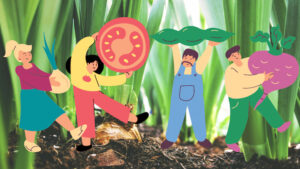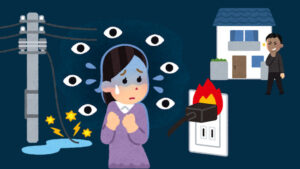CONTENTS
No food tomorrow…can you imagine?

Are you stockpiling food in case of a major disaster? Disasters don’t wait. You can’t wait until after it happens. For example, here are some possibilities: Distribution stops due to the destruction of lifelines, supermarkets and convenience stores are also damaged and cannot sell their products, and even if you are lucky enough to find a store, the shelves are empty.
In times of disaster, the unimaginable becomes a reality. It is dangerous to wait for days for disaster relief supplies to be distributed, not knowing when aid will arrive. What you can rely on at such times is the food you have stockpiled in advance. Let’s figure out together exactly how many days’ worth of food you need to stockpile!
Why do we need emergency food?
Let’s look back at past earthquakes. Comparing the Great East Japan Earthquake (2011), the Kumamoto Earthquake (2016), and the Northern Osaka Earthquake (2018), it took several hours to several months for infrastructure such as water, gas, and electricity to be fully restored; in the Great East Japan Earthquake, it took approximately 6.5 months to complete restoration of water supply(*1)
Until the situation calms down, it is expected that disaster relief supplies will not arrive for several days, and of course, supermarkets and convenience stores will become dysfunctional. Therefore, each household should be prepared with emergency rations.
How many days on earth do you need?

It is said to be a minimum of 3 days x number of people, but in case of destruction of logistic bases and considering the recent damage, we recommend securing food for 1 week x number of people.
(The amount of food varies from person to person, so some people may need more than that.)
More water needed than you think
It is said that drinking water is the same as food and that a minimum of three days’ worth is needed, but it is best to have at least a week’s worth (about 3 liters per person per day). (*2) Even if the water supply is not cut off, it may become unhygienic to drink due to cracks in the water tank of the apartment building, muddy water, etc., so it is recommended to have a larger supply. In addition to drinking water, you will need water for washing dishes, hands, toilets, etc.
Cassette stoves and cylinders that are convenient to have
Although there are emergency rations that can be eaten without fire or water, it is better to eat something warm so that you can lead a normal life and feel mentally secure. It is recommended to have a cassette stove/cylinder to heat retort pouch or instant noodles and boil water. 6 cassettes are said to be necessary per person per week(*3).
Where do you store that stockpile?

We recommend that you keep them in a place that is easy to manage on a daily basis. There is no point in going to the trouble of stockpiling if you end up closing it away in the back of a shelf, not being able to retrieve it because the shelf collapses during an earthquake, or not being able to find it when you try to look for it. It is a good idea to keep them in a place where they can be retrieved at any time, or to create a dedicated storage space for emergency rations.
Also, if dust or mold grows on the surface, it is a hygienic concern. For example, even if the dirt can be wiped off with water, the key is how much precious water is not used during a disaster, so it is important to keep the storage tidy and clean on a regular basis.
Let’s figure out what emergency food we have now.
It is recommended that you make a list of the items you purchased in advance so that you can instantly envision what you really need, such as if you thought you had stockpiled enough but actually did not have enough at all, or if you underestimated the number and even bought extra items. For example, it is a good idea to share information such as product name, expiration date, and number of items with your family.
(※1)(※2)(※3)
Source:Ministry of Agriculture, Forestry and Fisheries, “Situation Concerning Household Stockpiling of Food,” used March 1, 2022.
writer:Matsuoka







